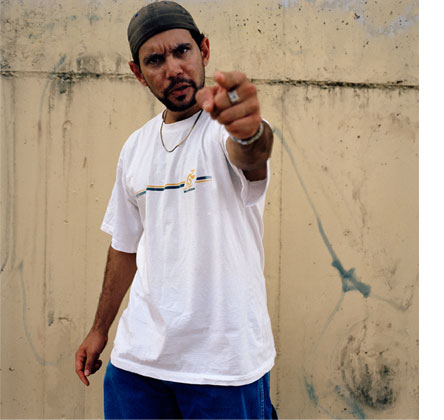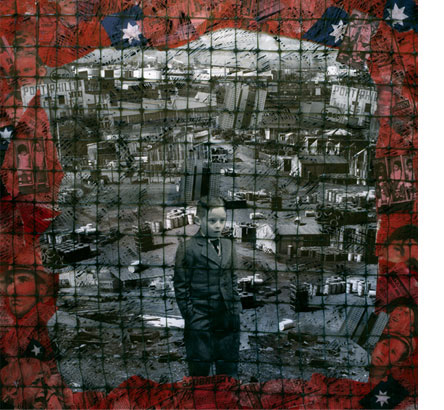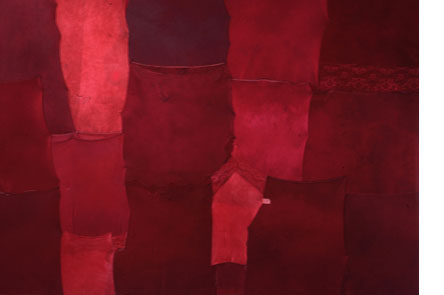
Performing Aboriginality
Encountering Culture: A Dialogue
Out of Place
Atonement
Lost in Translation
Displaced Objects
Wind in Utopia
Habitat: A Question of Place
![]()

Performing Aboriginality (2009 - current)
My artistic practice and research has grown out of an on-going
cycle of annual returning to Alice Springs/Central Australia which began
in 1993 (December-March), fortuitously enabled by winning The Alice Prize
in 1991 (Judge: Jenepher Duncan).
In time, I developed a close relationship to specific Aboriginal families living
in, and around, the township of Alice Springs, a social network made possible
through my initial relationship to Erica Franey. To date, two large bodies of
photographic work, Out of Place (2001-02) and Encountering Culture: A Dialogue
(2006) have been the result of those personal and professional relationships.
Performing Aboriginality will be the third component of what, I consider, to
be a conceptual trilogy on the everyday “lived” life of Alice Springs.
Publications
Togart Award 2010
Catalogue
Togart Award 2009
Catalogue
Links
Interventions @ The Australian Anthropological Society Annual Conference 2009
The production of art as an area of social action
National Library of Australia—Catalogue: Interventions: Experiments between Art and Ethnography
The South Project (Melbourne 2010: How does a network…?)
Steve Gumerungi Hodder Watt
Encountering Culture: A Dialogue (2006)
Digital photographic print
112.0cm x 106.5cm
![]()

Encountering Culture: A Dialogue (2006)
Encountering Culture: A Dialogue is a contemporary document on the polemics of urban life in Alice Springs seen through the prism of Aboriginal youth - the site of testimony and lived experience. It examines the inter-subjectivities of contemporary Aboriginal life in Alice Springs. It presents both the mundane nature and theatricality of the everyday. Identity politics, performance, and self-presentation are played out within the specifics of place, together with the power of encounters and human relationships. It comprises of 60 large-scale photographic works, each work 112.0cm x 106.5cm.
Links
Photographic project challenges stereotypesGertrude Contemporary: Chris Barry (Past Studio Artists)
Biography, Volume 28, Number 1, Winter 2005 (Chris Barry: Dialogues and Self Constructions)
Auto/Biography and
Mediation
Julie Woodford, Rosie Parsons, Athena Magoufakis, Sasha AhChee, Lisa Kunoth & Ricki-Lee Tilmouth
Encountering Culture: A Dialogue (2006)
Digital photographic print
112.0cm x 106.5cm

Out of Place (2001-02)
Out of Place is a project about the specifics of place and the particularities of location, Alice Springs/Central Australia, a geographical location loaded in history, symbolism, and an archive of political and social analyses—framing a historically contested site. One immediately enters into the dynamics and discourses of binary Australia: nature/culture, colonial/postcolonial, Indigenous/non-Indigenous, resemblance/non-resemblance, masculinity/femininity, fear/desire, and so forth. Issues of representation/non-representation, possession/dispossession, silence/resistance, visibility/invisibility come into historical play and replay: the troubled mappings of our colonial past.Alice Springs is a bi-cultural township. Aboriginal families have been permanent residents since time immemorial, in spite of successive epochs of destructive governmental policies. Gayatri Chakravorty Spivak states that culture alive is its own irreducible counter-culture. She also states that culture is a space of collision.
Chris Barry
Pool
Out of Place (2001-02)
Lightjet digital photographic print
78.0cm x 108.0cm
Publications
landscape.country
(Chris Barry)Stereoscopic Histories
(Chris Barry)Links
Gertrude
Contemporary:
Chris Barry (Past
Studio Artist)Adam Art Gallery/
Te Pataka Toi
Victoria University, Wellington
National Library of
Australia
--Catalogue:
landscape.country

Atonement (2002)
In 1992, I had an exhibition Lost in Translation at the Mala Galeria, Museum of Contemporary Art in Warsaw, Poland. Whilst visiting my family in Lodz, I asked my cousin to take me to the Jewish cemetery. I borrowed a Rolli reflex camera from the director of the gallery and then proceeded to photograph the cemetery in the midst of a golden Polish autumn – ‘Polska zlota jesien’. The place was covered in yellow leaves that began to resemble deep snowfalls. I remember being totally intoxicated by this atmosphere of heavy autumn. Memory, beauty, nostalgia, longing, belonging… flooded my senses and imagination – the sensory and emotional phenomena associated with the cyclic nature of autumn, time passing, and the enigma of the homeland place. My cousin couldn’t understand why I wanted to photograph the Jewish cemetery, but I knew instinctively upon entering and passing through the gates, that this would be my gesture of atonement.
Chris Barry
Polska Zlota Jesien (A Golden
Polish Autumn)
Atonement (2002)
Inkjet print
70.0cm x 70.0cm
Publications
Atonement (Catalogue Essay by Kay Ferres)
The Enigma of the Homeland Place (Chris Barry)
The Translative Space of Art (Chris Barry)
Links

Lost in Translation (1988 & 1992/1996)
The word ‘translation’, Salman Rushdie tells us, ‘comes, etymologically, from the Latin for ‘bearing across’. Having been borne across the world, we are translated… It is normally supposed that something always gets lost in translation; I cling, obstinately, he says, to the notion that something can also be gained’. What is gained, according to Rushdie, is a ‘stereoscopic vision’ whereby the immigrant or exile lives in the dichotomous state of insider/outsider simultaneously. S/he is able to offer a ‘double perspective’ (Rushdie: 1992:17-19).Lost in Translation is a series of 15 photographic works originally produced in 1988 as Cibachrome photographic prints or direct positive colour photographs (50.0cm x 50.0cm) entitled Displaced Objects 2. In 1992 these same works were enlarged and reprinted as Type C photographic prints (127.0cm x 127.0cm/152.0cm x 127.0cm) and renamed, Lost in Translation. A suite of selected works were exhibited at the Mala Galeria, Centre for Contemporary Art, Ujazdowski Castle, Warsaw, Poland; and part of an international symposium, Pop Culture and Australian Identity, staged by The Australian Studies Centre, University College London (Director: Richard Nile). In 1996, selected works were featured in a survey exhibition, Wind in Utopia, Australian Centre for Contemporary Art (ACCA), Melbourne, Curator: Jenepher Duncan.
Chris Barry
Occidental Tourist
Lost in Translation 1988 & 1992/96
Direct positive colour photograph/
Type C photographic print
50.0cm x 50.0cm/127.0cm x 127.0cm
Publications
The Translative Space of Art (Chris Barry)
Lost in Translation: Photo-installations by Chris Barry
(Freda Freiberg)Links
Griffith University Art Collection (Puppet)
Griffith University Art Collection (Nocturne)

Displaced Objects (1986/1996)
Exiles and immigrants are very often ‘haunted by some sense of loss’ writes Salman Rushdie in Imaginary Homelands, ‘some urge to reclaim, to look back, even at the risk of being mutated into pillars of salt’. Yet, if we do look back’, he warns, ‘we must also do so in the knowledge – which gives rise to profound uncertainties – that our physical alienation… inevitably means that we will not be capable of reclaiming precisely the thing that was lost; that we will, in short, create fictions… imaginary homelands’ (Rushdie 1992:10).
Displaced Objects is a series of 14 photographic works originally produced in 1986 as Cibachrome prints or direct positive colour photographs (50.0cm x 50.0cm). In 1996, these same works were enlarged and reprinted as Type C photographic prints (127.0cm x 127.0cm) as part of a survey exhibition entitled, Wind in Utopia, staged at the Australian Centre for Contemporary Art (ACCA) in Melbourne.
Chris Barry
Untitled (Self Portrait)
Displaced Objects 1986/96
Direct positive colour photograph/
Type C photographic print
50.0cm x 50.0cm/127.0cm x 127.0cm
Collection: Australian National Gallery &
National Gallery of Victoria
Publications
Displaced Objects, or
Sittings for a Family
Portrait (Chris Barry)Contemporary Australian Collage and its Origins (Freda Freiberg)
Links
National Gallery of Victoria (NGV Collection)
Griffith University Art Collection (Rhapsody in Green and Yellow)
Griffith University Art Collection (Epitaph)

Wind in Utopia (1996)
Publications
Seductions and Tyrannies (Catalogue Essay by Ffion Murphy) in, Wind in Utopia.
The Double Life of
Krystyna (Catalogue
Essay by Richard Nile)
in, Wind in UtopiaLinks
X is the Site of Many Accumulations (1996)
Wind in Utopia
Textiles on board
175.0cm x 240.0cm
![]()

Publications
Chris Barry,
Her Stories
(Catalogue Essay
by Raffaele Caputo)Links
National Gallery of Victoria (NGV Collection)
Detail
Untitled (1990-1996)
Type C photographic print
180.0cm x 127.0cm (each print)